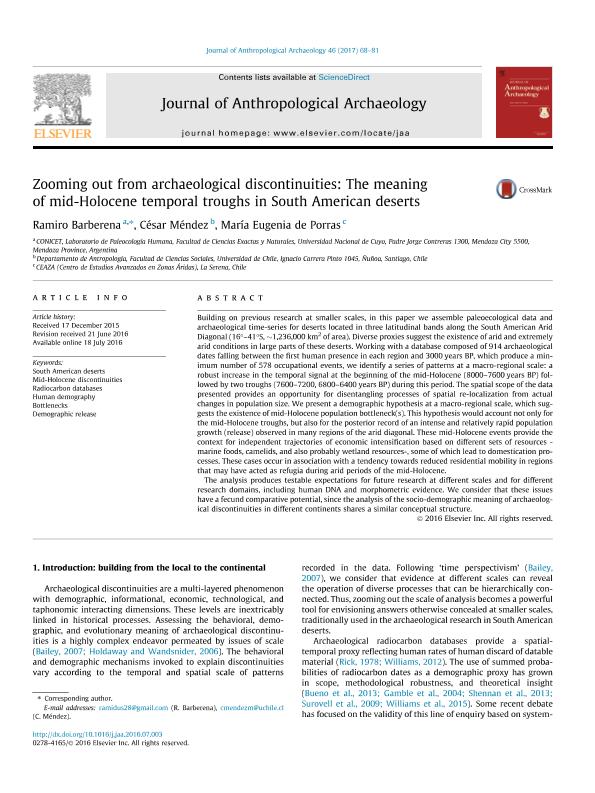Artículo
Zooming out from archaeological discontinuities: The meaning of mid-Holocene temporal troughs in South American deserts
Fecha de publicación:
06/2017
Editorial:
Academic Press Inc.
Revista:
Journal of Anthropological Archaeology
ISSN:
1090-2686
Idioma:
Inglés
Tipo de recurso:
Artículo publicado
Clasificación temática:
Resumen
Building on previous research at smaller scales, in this paper we assemble paleoecological data and archaeological time-series for deserts located in three latitudinal bands along the South American Arid Diagonal (16°–41°S, ∼1,236,000 km2 of area). Diverse proxies suggest the existence of arid and extremely arid conditions in large parts of these deserts. Working with a database composed of 914 archaeological dates falling between the first human presence in each region and 3000 years BP, which produce a minimum number of 578 occupational events, we identify a series of patterns at a macro-regional scale: a robust increase in the temporal signal at the beginning of the mid-Holocene (8000–7600 years BP) followed by two troughs (7600–7200, 6800–6400 years BP) during this period. The spatial scope of the data presented provides an opportunity for disentangling processes of spatial re-localization from actual changes in population size. We present a demographic hypothesis at a macro-regional scale, which suggests the existence of mid-Holocene population bottleneck(s). This hypothesis would account not only for the mid-Holocene troughs, but also for the posterior record of an intense and relatively rapid population growth (release) observed in many regions of the arid diagonal. These mid-Holocene events provide the context for independent trajectories of economic intensification based on different sets of resources -marine foods, camelids, and also probably wetland resources-, some of which lead to domestication processes. These cases occur in association with a tendency towards reduced residential mobility in regions that may have acted as refugia during arid periods of the mid-Holocene. The analysis produces testable expectations for future research at different scales and for different research domains, including human DNA and morphometric evidence. We consider that these issues have a fecund comparative potential, since the analysis of the socio-demographic meaning of archaeological discontinuities in different continents shares a similar conceptual structure.
Archivos asociados
Licencia
Identificadores
Colecciones
Articulos(CCT - MENDOZA)
Articulos de CTRO.CIENTIFICO TECNOL.CONICET - MENDOZA
Articulos de CTRO.CIENTIFICO TECNOL.CONICET - MENDOZA
Citación
Barberena, Ramiro; Méndez, César; de Porras, Maria Eugenia; Zooming out from archaeological discontinuities: The meaning of mid-Holocene temporal troughs in South American deserts; Academic Press Inc.; Journal of Anthropological Archaeology; 46; 6-2017; 68-81
Compartir
Altmétricas




